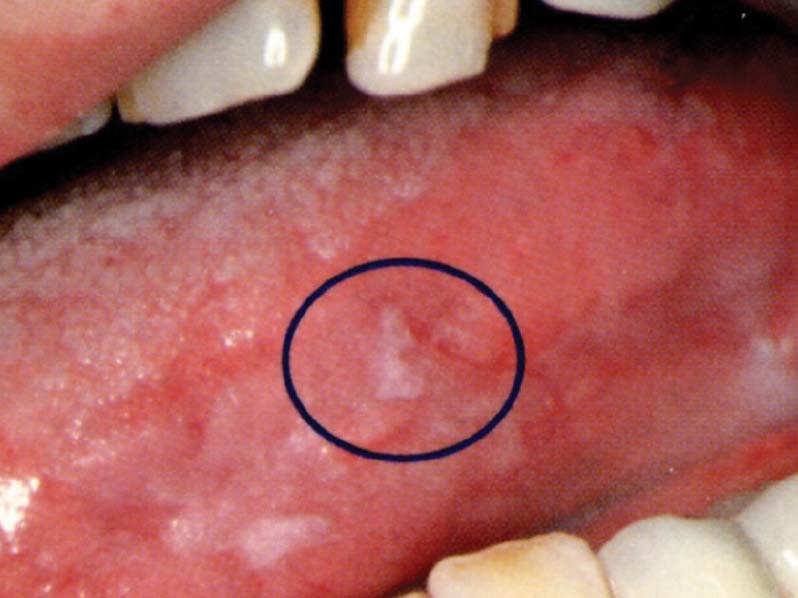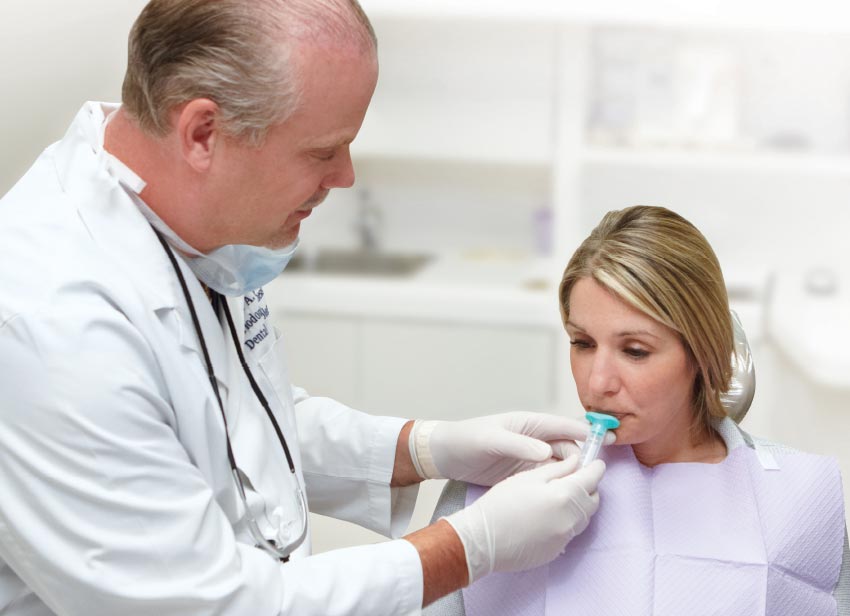New Saliva Test For Oral Cancer
Life-saving technology aids early detection
What do these famous people have in common: Sigmund Freud, pioneer of psychiatry; Aaron Spelling, renowned television producer; Mary Wells, Motown singing sensation; and Tony Gwynn, celebrated slugger of the San Diego Padres?
The unfortunate answer is: They all died from oral cancer. This disease causes about one death every hour in the US alone. Around the world, about half a million people are newly diagnosed with it each year. That's nowhere near the incidence of lung or breast cancer — but oral cancer is associated with another ominous statistic: After diagnosis, its five-year survival rate is only a little better than 50/50 — and that rate hasn't improved significantly in decades.
The risk factors for oral cancer include some that are common to several other diseases: tobacco use, excessive alcohol consumption, older middle age and genetic predisposition. But the fastest-growing group of people with oral cancer is non-smokers under age 50. The cause of this disturbing trend is thought to be a particular strain of the human papilloma virus, HPV-16, which is spread by sexual contact. HPV also causes over 90 percent of all cervical cancers. This puts even young non-smokers at risk.
Oral cancer often produces few noticeable symptoms until the disease reaches its later stages: that's what makes it so deadly. By the time it is found, treatment may be difficult, and the cancer often recurs. Yet if discovered early, the survival rate can reach 80-90 percent; this is what makes early detection of oral cancer such a priority. At present, many dentists perform visual screenings for oral cancer during routine dental checkups. If a potential abnormality is found at a dental exam, the patient is often referred to an oral surgeon, who may perform a biopsy to determine whether oral cancer is present. And that's where things get complicated….
The Biopsy Dilemma
Biopsy is the gold standard for detecting oral cancer. Generally, this procedure involves the surgical removal of tissue in the region where cancer is suspected — for example, on the lip or tongue. The tissue is then analyzed in a pathology lab to determine whether cancer is present. While the pathology laboratory test for cancer is highly accurate, decisions surrounding the procedure are far more complicated.
 |
| Generally, a biopsy involves the surgical removal of tissue in the region where cancer is suspected — for example, on the tongue. |
No one wants to take a chance on missing oral cancer, because the consequences of failing to spot it are so great. Yet the vast majority of biopsies — over 90 percent of them — reveal that cancer is not present. This certainly comes as a relief to many worried individuals; but it also means that in most cases the invasive surgical procedure later turns out out to have been potentially avoidable. At the same time, some patients who do have cancer put off getting a biopsy because of its very invasiveness. This delay may add to the problems associated with late treatment of the disease.
Like any surgical procedure, a biopsy carries a small risk of bleeding, infection, or adverse reaction to anesthesia. What's more, performing a thorough biopsy in many cases means removing a significant amount of tissue, primarily to ensure that no cancer is missed. A clinical decision must be made, weighing the need to find this potentially fatal disease against the potential for disfigurement or loss of function that could result from the procedure. Naturally, most would agree that it's best to err on the side of caution, even though the results will be negative more than 9 out of 10 times. But if prediction methods could be improved, giving us a better idea of who really needed a biopsy and who was at extremely low risk, the efficiency of diagnosis could be improved.
A New Diagnostic Method
In the early 2000's, the National Institutes of Health sponsored basic clinical research on a new concept: using saliva to diagnose disease. Saliva offers several advantages over blood, the biofluid used for many standard medical tests: It's easy to collect, store and process; it doesn't require a skin puncture or other invasive procedure; and it eliminates the risk of transferring blood-borne diseases. What's more, in some instances saliva can actually provide better information than blood.
 |
| Saliva offers several advantages over blood, the biofluid used for many standard medical tests: It's easy to collect, store and process; it doesn't require a skin puncture or other invasive procedure; and it eliminates the risk of transferring blood-borne diseases. |
In recent years, saliva has become a valuable diagnostic tool. It is used to identify infectious agents such as the HPV or HIV virus. It can measure the levels of hormones, such as estrogen, melatonin, or cortisol, which are actually available to the body at a particular time. It can also be used to screen for illicit drugs such as opioids, and as a basis for DNA testing.
For over a decade, research conducted by Dr. David Wong of the University of California at Los Angeles has been aimed at expanding the reach of salivary diagnostics for detecting oral cancer. The test is available now under CLIA (Clinical Laboratory Improvement Amendment) regulations. Pending FDA approval, it will become more widely available in dentists' offices and other clinical health-care settings. The test doesn't replace a biopsy — but it provides valuable information that can help us make better decisions about whether a biopsy is really needed.
The Markers of Disease
How does a salivary diagnostic test work? Contrary to what you might think, it doesn't detect cancer itself. Instead, it looks for specific molecules called biomarkers, which the body develops in response to a particular disease. When oral cancer is present, it causes certain genes in the body to become active. Genes are made up of many units of DNA (deoxyribonucleic acid), the massive double-stranded molecule that carries the genetic code in humans. When activated, genes direct cells to produce molecules called proteins, which are vital to many biological processes.
The cellular machinery DNA employs to make proteins also involves another molecule: the single-stranded ribonucleic acid, RNA. The salivary test for oral cancer is designed to detect RNA molecules that could signal the presence of this disease. After studying a wide variety of biomarkers, Dr. Wong found specific RNA molecules which, when present in low concentration, indicate the absence of oral cancer with a high degree of confidence; conversely, when the levels of those molecules are elevated, cancer is more likely to be present.
In relying on biomarkers to identify disease, the salivary test for oral cancer is similar to the common blood test for prostate cancer, the PSA (prostate-specific antigen) screening. Both tests have a similar accuracy in terms of finding disease when it's present (sensitivity), and in correctly identifying people who are disease-free (specificity). Yet the two diseases are quite different: Prostate cancer is generally slow to develop, while oral cancer is an aggressive and fast-growing disease. This trait, combined with the fact it's usually discovered in the later stages, is what makes it so dangerous.
Scoring the Test
Using the salivary test is as about simple as it gets: After collecting about 2 cc of saliva in a container, the sample is sent to a lab for testing. Within 24 hours, a score (ranging from 0.00 to 1.00) is returned. A low score means that cancer is not present, with a confidence of nearly 99%. (In statistical terms, the test has a high negative predictive value.) Samples with medium to high scores indicate a risk factor that's two to three times higher: It's not a sign that cancer is present, but an indication that further testing should be considered — especially if risk factors are present.
Because oral cancer is a low-incidence disease, the salivary test isn't recommended for screening the general population. Instead, it's designed to be used when risk factors are present, or when there is a suspicion that cancer may exist. Based on the results, a patient might be advised to see a cancer specialist, who may recommend doing a biopsy right away, or closely monitoring the situation over time. The test won't replace a biopsy for making a definitive diagnosis of oral cancer… but it could save many people from having biopsies that later turn out to be negative. At the same time, it could also encourage people to avoid delaying biopsies in cases where cancer is present.
A Brighter Future… Within "Spitting" Distance!
If salivary testing works so well for oral cancer, could it be used to find other diseases? The answer seems to be yes: Salivary tests for several other health conditions are presently being developed. One of particular interest to dentists is Sjogren's syndrome, an immune system disorder that often causes dry mouth. Since it affects the salivary glands, biomarkers in saliva might be expected to reveal its presence. Indeed initial studies from UCLA show promise for salivary proteins and RNA to help with the early diagnosis of this disease, which often goes undetected for many years.
If salivary testing works so well for oral cancer, could it be used to find other diseases? The answer seems to be yes: Salivary tests for several other health conditions are presently being developed.
Diabetes is another disease that could potentially be diagnosed by testing saliva. Based on preliminary biomarker studies, it seems possible to one day identify an early stage of the disease, pre-diabetes — perhaps even before it can be identified by routine blood testing. Salivary testing also shows promise for detecting certain types of lung cancer, where performing a biopsy can be even more invasive than for oral cancer.
As new diagnostic methods are developed, new technologies for laboratory analysis are keeping pace. In the near future, rather than sending fluid samples to a central laboratory, testing could be performed at the point of care: in your dentist's office, for example. It's possible that a desktop machine could one day perform sophisticated tests and return your lab results in minutes. It's even possible that hand-held devices might be used to monitor and contain outbreaks of infectious disease, by identifying the biomarkers of bacteria and viruses at locations spread across the world.
But closer at hand, the use of salivary diagnostics to help find and treat oral cancer is expected to become more widespread as its acceptance grows among patients, doctors, and insurers. Easy to use, inexpensive and accurate, this new non-invasive testing method will be a welcome development for patients and doctors alike.

